From the moment I decided to visit Eastern Europe I was obsessed with the idea of Transylvania. My mind conjured images of razorback mountains with rugged roads where one false move would send hikers plunging to their deaths. I imagined black-green forests so dense that not even the midday sun could penetrate and wolves howling beneath the spilled glitter of the Milky Way. Though I’d ignored the Twilight TV series that had gripped the collective fascination, I read Bran Stoker’s Dracula prior to arriving in Romania; as a result the Transylvania in my mind was also peppered with visions of vampires and Dracula. A romantic at heart, I desperately wanted to believe that this corner of the world was still remote, untouched, and mysterious.
However, Transylvania is a very large region in northern Romania, so when I left Turda I had a decision to make. I could head due south to Sibiu or southeast to Brasov. In the end I chose the latter for its proximity to Bran Castle, better known as Dracula’s Castle in tourism circles. I arrived in Brasov late one afternoon following a long, hot train ride, only to be held up by a taxi driver who tried to charge me more than four times the normal rate to take me to Old Town. Instead, I squeezed into a few inches of space on the stairs of an overloaded bus and held on for dear life as we careened around curves, simultaneously swiping at the sweat pouring down my forehead while trying to keep my suitcase from rolling out each time we jolted to a stop and the doors flew open.
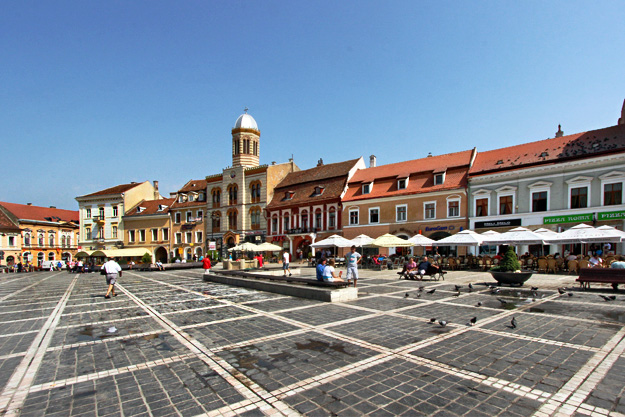
After a delicious dinner and a good night’s sleep I left the frustrations of the precious day behind and headed out to see Brasov. Piata Sfatului, the town’s main square, was a disappointment. The central fountain was dry and trash was strewn around its base. Many of the stone pavers were chipped or cracked and some were missing entirely. A worker trickling water onto spilled ice cream stains succeeded only in making them stickier. Further along I found Nicolae Titulescu Park where I strolled through neglected rose gardens. Circling back, I followed a path alongside earthen fortifications built to protect the town during medieval times. A rank odor rose from a small stream that bordered the path and gray soap scum floated on its surface. Brasov seemed seedy, dilapidated, and poorly maintained – a town in decay.

Discouraged, I spurned Brasov and booked a tour of the surrounding countryside the following day, where I was certain I would discover the real Transylvania. We drove south into Carpathian Mountains that were every bit as spectacular as I had imagined. Sinuous roads led past clusters of Swiss chalets tucked into the haunches of soaring granite giants. Since I was the only client that day, we made an unscheduled stop at the Christian/Orthodox Caraiman Monastery (Holy Cross Monastery) in Busteni, which was completed in 2000. My guide, who “got religion” after years spent negotiating arms deals for the communist government, explained that the Virgin Mary appeared in the dreams of a local priest, father Gherontie Puiu, indicating where the monastery should be built by making a flaming cross appear in the sky. Today a neon cross hangs in a large tree on that very spot and pilgrims flock to the site to offer prayers or seek healing.
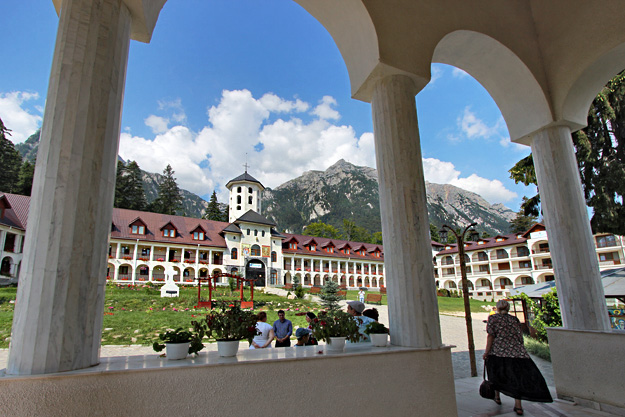
We continued south to Sinaia, another Swiss clone village where Peles Castle rests atop a rock aerie, its needle-like turrets mimicking the serrated peaks that frame it. Technically a palace, Peles was built for King Carol I, who fell in love with the Transylvanian scenery during his first ever visit to the area in 1866. Construction was begun seven years later and the castle was opened in 1883, though it was not completed until 1914. I toured parts of the first and second floors, seeing only a fraction of its 34,000 square feet and 170 rooms, but what I saw was magnificent.
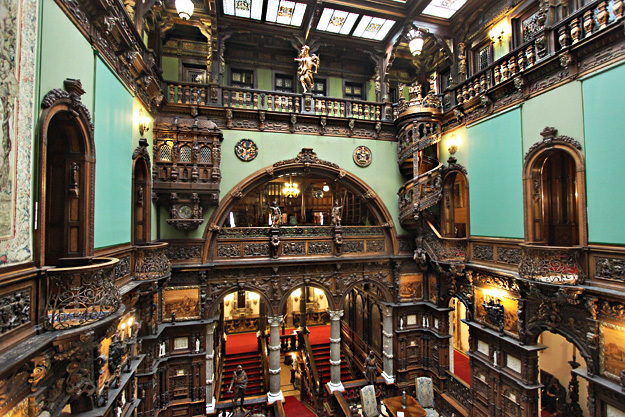
In the three-story Hall of Honor, exquisite balconies, a spiral staircase, and a prayer cabinet are carved from exotic woods and a retractable stained glass roof floods the space with natural light. A salon decorated in Moorish style features mother-of-pearl inlaid furniture, Persian rugs, and a marble fountain. The solid bronze doors of the Italian Renaissance style Florentine Room were made in Rome and the Grand Marble Fireplace has Michelangelo motifs. The Turkish parlor, used as a mens’ smoking room, is full of Turkish rugs and copperware, and its walls are covered in silk brocade imported from Vienna. The castle has one of the most extensive collections of art in Eastern and Central Europe, including more than 4,000 pieces of armor.

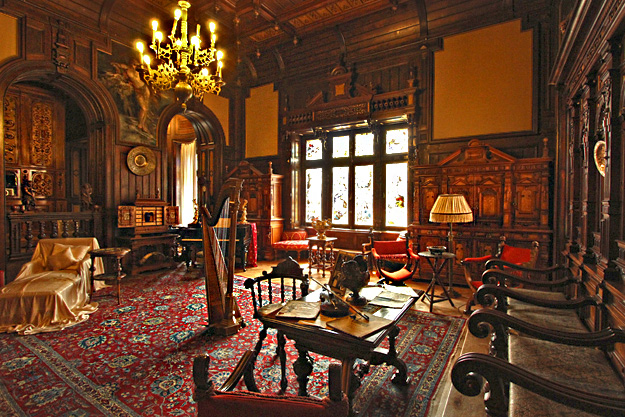
Two hours later I climbed back in the car, eager to visit the highlight of the tour, Bran Castle. Goosebumps broke out on my arms when it came into view, soaring high above the town. The massive stone hulk squatted beneath terracotta spires that seemed to have been attached at random, with no concern for aesthetics. From a distance, it was impressive. Up close, it was a circus. The streets were filled with kiosks and tents selling food and trinkets. I grimaced and pressed through the crowds of tourists, hiking up the hill to the castle entrance. Most of the rooms were unfurnished, cold, and damp, containing only signboards that explained the history of the castle and the legend of Dracula.
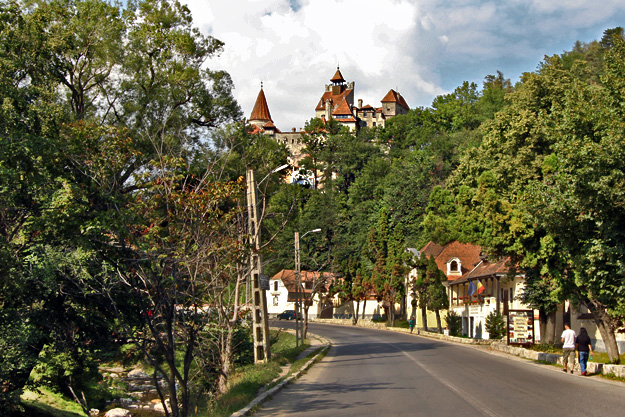
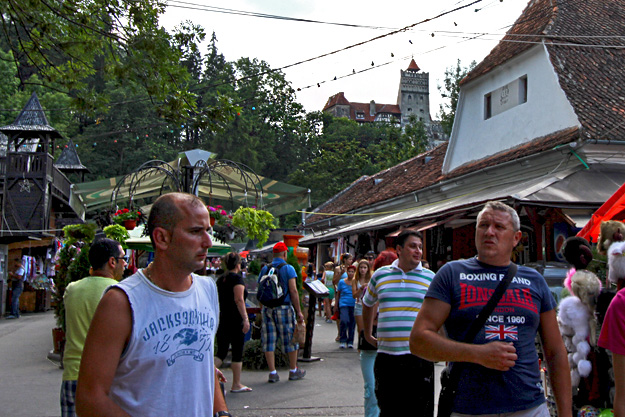
Of course, I knew that Dracula was a mythical character, created by Bram Stoker and loosely based on the true-life stories of Vlad Dracul II, a Romanian prince who, in 1448, was appointed by the Ottomans to rule Wallachia, an area that borders present day Transylvania. Vlad was supposed to be governing on behalf of the Ottomans but he was an ambitions tyrant who wanted lands of his own, and he knew that the quickest way to succeed was to establish a reign of terror. He began cutting off the heads of his enemies and mounting them on stakes in front of the castle, earning him the nickname Vlad the Impaler. But the name that would forever become associated with him came from his membership in the Order of the Dragon, an organization created by the King of Hungary to ensure the safety of the royal family and later, to protect Christianity against its enemies. Upon his appointment to the order Vlad signed the official documents with the moniker Dracula.
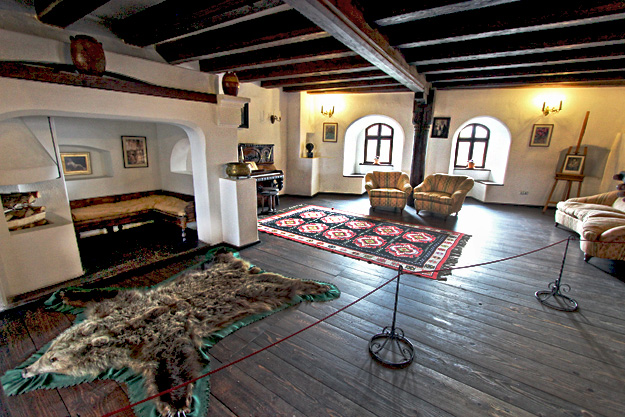
Fearing that control of Wallachia would be wrested from them, the Turks eventually marched against Vlad but when Muhammad II, conqueror of Constantinople, arrived he found the heads of his entire army gruesomely displayed on stakes for miles surrounding the castle. Unfortunately, that castle was not in Bran. Though historians do not agree on the location of Dracula’s Castle, Snagov Monastery and Poienari Fortress, both located in the southern Carpathians, are more likely candidates. So why does the legend persist and why do tourists flock to this false monument? Although Vlad the Impaler never set foot in Bran Castle, it was the inspiration for Bram Stoker’s Dracula, the novel that established the legend.

My tour continued for another hour; we made a final stop at Rasnov Fortress on our way back to Brasov, but my heart was not in it. I gazed up at the fortress, on a hill overlooking the village of Rasnov, and shook my head. Too tired to tackle one more climb, I settled for a view from afar. I stayed one more day in Brasov and it was a bad decision, as I got food poisoning from the restaurant I chose on my final night and spent the rest of the night chained to the bathroom. Brasov was a huge disappointment to me but I can still look on the bright side; at least I got out of there with my head intact.
Check prices for accommodations in Brasov at Booking.com, Hotels.com, or HotelsCombined.com. Read reviews about hotels and guest houses in Brasov, Romania at TripAdvisor.
Disclosure: This article contains affiliate links to hotel booking sites. If you click on any of the links and make a booking, I may earn a small commission, which keeps this blog free to read.

Hi there. We weren’t hugely impressed with Brasov either, it just felt too touristy, we were dodging the gortex-clad tour groups on the pavements. But it is a very pretty town and we stayed in a wonderful little apartment there. It was my son’s birthday and we had most excellent ice cream followed by a trip to Bran Castle. I must admit, we thought the castle and trinket stalls were lots of fun, a few spooky Dracula stories and images are great for the kids. We didn’t pay to go in, the inside of stately homes usually bores the kids to tears. We travelled on to Sighisoara, birth place of Vlad. That’s a gorgeous little town, but again, very touristy. We’re up here in Breb now ( it’s me you’ve been talking to on Facebook about living here). It’s another world in northern Maramures, far from the crowds and pizza joints. You can tell when you cross the border from Transylvania to Maramures, it feels and looks different. We call it home now, for a while. Looking forward to exploring more of this end of Europe.
Hi Allyson – I know I’ve replied to you in another forum, but wanted to say again how thrilled I am that you are getting to explore the Breb area. It’s one of the most gorgeous, and authentic, places I’ve ever visited.
DEZ NUTZ
Hi there nice article and nice images ,i really respect your passion into traveling,i like drakula movies,but do they exist really??
Hi Tahnoon: I think that’s for each person to decide – for me Dracula is just a legend, but I bet there are a lot of people who believe vampires actually exist.
Thanks for exposing Bran Castle as a tourist trap …. the other castles/monasteries you went to look positively exquisite though!
Thanks Selma! I really detest tourist traps, so do try to be honest about them when I come across them. But to its credit, most of the country is devoid of tourist traps and full of wonderful cultural experiences.
Come to the only Transylvania left on Earth. Western North Carolina Transylvania’s County seat is Brevard NC, my home town, 2200 foot elevation, getting 70+ inches rain per year and surrounded by over 100 water falls, lush forests, mountains ranging from 4,000 – 6,000 feet. Nearby Asheville has a castle too, The Biltmore House, pricey to tour but beautiful.
Work and life strand me elsewhere, but I remember home fondly. Go where locals eat, in season shop the various farmers market especially the big one near Asheville.
Hi Ed. Had a good laugh over your comment. Transylvania County in North Carolina is a world of difference from the Transylvania in Romania, but it is beautiful. I’ve traveled extensively through that part of NC, hiked to many of the waterfalls, and written extensively about the area. You’re right that it is a beautiful place.
Wow, marvelous blog format! How long have you been blogging for? You make running a blog glance easy. The total glance of your site is great, as neatly as the content material!
i like your blog you done a very good job, i must say your blog will going top.
i have never words to explain Romanian…i also great experience of Roamnia ..Its really ultimate place to visit..There are lot of things and fantastic natural views…Thanks for sharing your wonderful experience with beautiful pics…
I agree, Jacob. Romania is an amazing, unique country. I suspect I could travel there for years and never grow bored.
Romania is best place to visit..last year i visited Romania..its really great experience for me..there are lot of beautiful places and natural views which are main attention to the visitors…Really outstanding pics and post… i appericiate for this informative work…
Thank you Ethan. Romania definitely has a lot to offer to the tourist. Glad you had a similar experience to mine and thanks for sharing it here.
I tried to write a comment on my phone but failed so I am giving it another go on my PC.
I would only like to say that, if you are going to Romania, make sure you will visit Brasov. Although Barbara seems to have had a less then acceptable experience, for whatever reason, you can be assured that you will not regret it if you decided to visit the city. It has great historical monuments (The Black Church, The first Romanian School, The Medieval Towers surrounding the city, The Brasov Fortress, etc), natural beauty (it is surrounded by forests and mountains within walking distance) and even a cheesy Hollywood type of sign with the city name which is placed on top of one of the mountains.
One thing that I cannot understand is Barbara’s impression that the city was dirty and the main square was neglected and the park as well (though, I do agree that the fountain in the centre of Brasov needs to be refurbished ).
Brasov is well known as one of the cleanest, most civilised and European-like city in Romania. The park visited by Barbara (which I visited as well in September) is one of the cleanest and most cared ones I have seen in my life. The main square is also cared for.
I read this blog with interest but unfortunately I cannot help feel that the city described by Barbara does not exist. Again, the reason I posted this comment was because Brasov, as described in this blog post, does not exist. It is definitely not a question of taste, it is fact.
Hi Marius: Your comment was flagged because you included two outside links in it. I removed the links and published your comment. I appreciate that you really like Brasov;; different places certainly resonate with different people. However I take issue with your final line, “Brasov, as described in this blog post, does not exist. It is definitely not a question of taste, it is fact.” Perhaps I visited the city at the wrong time, but it does exist, I saw it and experienced it, as the photos show. Parts of it were fine, but others were sadly neglected. It was not a question of taste; it was a fact.
It’s interesting. People remember good fiction so much more than they do sound history. Time and again, they choose the memorable story over the facts.
How very true northierthanthou. And pretty sad, too.
Just back from Romania spending a week vacation.It was one of most memorable travel experience here .I loved the beauty of this place.Visited several muesums halls and enjoyed there a lot.Shopping facilities here are just mind Blowing.Overall perfect place to plan your trip .
Hi Ashley: Romania was a fascinating place for me as well. I love that they have held onto their many traditions.
Great narrative! I really like the pictures of the Peles Castle, especially the one of the Hall of Honor. The detail with which the wood is carved is remarkable..
Hi Marine: Peles Castle was the most beautiful castle I’ve ever toured.
Great storytelling, I recently came back from Czech/Prague and the square seems very similar. It was much cleaner/maintained there however. The castle and church look stunning.
Hi Tripmark: Prague’s Old Town is much more beautiful but Czechs seem to be over the tourists, and I can honestly say that though Brasov wasn’t nearly as nice looking as Prague, the locals were much nicer, so it has that going for it.
When I was in Romania a year ago I had to make the call between Bran Castle and Peles Castle. I chose Peles, and I’m pleased that I did. Your article confirms my suspicions about Bran. As a huge Dracula fan, I knew that the link between Bran and Dracula was tenuous (Bram Stoker never visited Romania, and could not have had a particular castle in mind when he wrote it), and that it is only pitched as such for tourists, although, of course, it is a beautiful castle in its own right.
I chose Peles in the end as I could imagine the Dracula tale taking place there just as easily as at Bran. Perhaps more so as it was far less touristy.
I must admit that I am hugely fascinated by Vlad. I spoke with many locals about him, and one thing is clear. He commands nothing but respect from Romanians. He is a hero. His methods were grisly but they were learned from the Ottomans and turned back on them.
I can highly recommend a trip to Snagov monastery, one of the locations where they believe Vlad to be buried. I was the only visitor all day when I went. There was no tourist circus surrounding it at all.
I enjoyed your post, I love to read other people’s opinions on Romania (it’s my favourite country).
Hi Brit: I’ll definitely add Snagov Monastery to my list for the next time around. I love discovering those kind of places that haven’t yet been overrun by tourists.
I had listen Dracula character many times but the reason behind its name hadn’t. Thanks Barbara Weibel for introducing Romania history.
You are very welcome, Nikunj. Romania was fascinating and I always try to delve into the history of the places I visit.
Vlad the Impaler was a Romanian prince, his father ruled Wallachia before him and he inherited the throne. The Ottomans wanted to conquer Europe and he was the only one who stood between them and Christianity. He was a hero for a the whole Europe.
Hi Laura. After reading your comment, I realized that I might not have made it clear that Vlad was Romanian, so I added that to the story. He and his father were captured by the Ottomans and spent many years living with them. As a result, Vlad learned the ways of the Ottomans, including their war tactics. When his father was killed, the Ottomans, who by then trusted Vlad, sent him back to rule over Wallachia on their behalf. Little did they know he would be their undoing. He is indeed the one who finally defeated the Ottomans and kept the rest of Europe safe from further invasions, though he did it in a particularly gruesome manner. Appreciate your comment.
Hey, Barbara! Thanks! Did you make it to Sibiu in the end? It’s my favorite city in Romania! 🙂
Hi Laura: Unfortunately, I didn’t make it to Sibiu and now believe it would have been a much better choice than Brasov. Just gives me an excuse to go back, though 🙂
As a Romanian, thank you very much. I find it funny I’ve been in Brasov countless times and never ever ever got a food poisoning. I would also have some harsh comments about your other experiences (like you expected Bran Castle to be home of Vlad Dracul?!?! It’s common knowledge it never was. It’s not Romania’s fault you get your info from “media hype”) and more but I’ll just refrain myself.
Please do us a favour: do not come back. Thank you.
Read what this guy has to say. But I guess he was in a different Romania, whaddayasay?
http://hashconspiracy.tumblr.com/post/21139571079/romania-a-surprise
Damn it, the more I read, the more angrier I get. This is the bus you “held for your dear life”: http://bit.ly/1k391PW The licence plate says “BV” which is the code for Brasov county. MAN buses, equipped for people with disabilities, and so on.
How can you lie like this?
Grig – read my article again. I never imply that the bus was old or unsafe. i was just the last person to get on board and so had to cram into a few inches of available space on the stairway. The only place for my rollerboard suitcase was on the other side of the metal bar that split the stairs in two, so in searing temperatures in an non-air conditioned bus, with one sweaty palm I was struggling to hold onto the metal railing as we rounded curves while, with the other, trying to keep my suitcase from rolling out the door whenever we stopped. It was exhausting and uncomfortable, but it’s a part of travel and one that normally I don’t dwell upon. The problem here was that I also didn’t much like Brasov, and I’m committed to telling the story of what happens to me on my travels honestly.
Hello again Grig – no, I think he was in the same Romania as me. Have you read my glowing articles abut Breb, Maramures; Cluj-Napoca; or Turda? Again, I am not attacking Romania – I like the country very much. It was just Brasov that did not resonate with me.
I can understand your excitement, and I almost didn’t want to read beyond the first paragraph as I was afraid it was going to shatter that fantasy in my head. However, I am glad I did, and I didn’t know the history and story of Vlad. Thanks.
Rhonda, one of the things that I didn’t mention in the story is that Vlad was born and spent his first few years in Sighisoara, a German-influenced town to the northwest of Brasov. It is apparently a lovely little town with gorgeous architecture and I wish I’d had time to visit. Also, I’m pretty sure I would have been much happier with Sibiu; I just made a wrong turn!
noooo i don’t want it to be a sham!
Hi Hogga: I think a lot of the problem is that no one can agree on where Vlad’s real castle is, so the myth based on Bram Stoker’s Dracula persists.
I never thought of Transylvania as one of the places that I just have to visit. There’s some unique beauty to the castle and always some good history behind it as well. Although it wasn’t what you expected, it’s great to be able to take it all in and make the best of every stop.
Hi Shereen: Transylvania is gorgeous and I only scratched the surface. Hope to go back some day to discover more.
Being of Hungarian decent, I always wondered what Transylvania was like myself. We’re travelling to Hungary and the surrounding countries next year…..Hopefully visiting family I have never met! After talking to Canadian Romanians and reading your story, I think your visit to Romania is good enough for me. lol Countryside does look beautiful though!!! Keep the travel stories coming. 🙂
Hi Steve – if you get a chance, do go to Romania. It’s a fascinating country and quite beautiful as well. But instead of Brasov, I’d choose Sinaia or Sibiu, further to the west, which was voted the European capital of culture a couple of years ago.
Indeed, not one of your better stops. It’s always disappointing to see how tacky some of these places are, especially when they are based on false information to start with. And the food poisoning sounds grim! Glad you got out of there safely and are happily in a new place now.
Hi Deborah: Brasov wasn’t horrible, it just compared poorly against all the other places in the country I visited. And the food poisoning surely didn’t help my mood, although I’m aware that can happen anywhere.
Looks like Peles castle was a more fitting place to imagine the legend of Dracula
LOL Heather, I thought the exact same thing.
I think they might as well embrace it all over the world. England can have Robin Hood’s house and King Arthur’s castle, Italy already has Juliet’s house, Mexico can have Zorro’s lair, and so on. It would be ridiculous, but we’re already on the way with a few of those.
Hi Snarky Nomad – guess you can’t blame a city for grasping onto whatever it can to promote tourism.